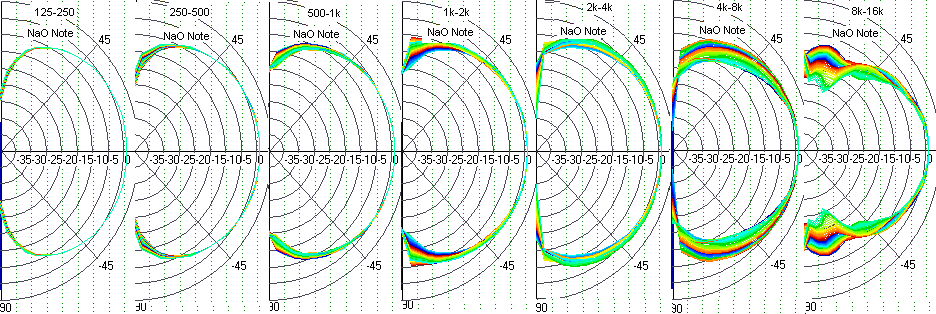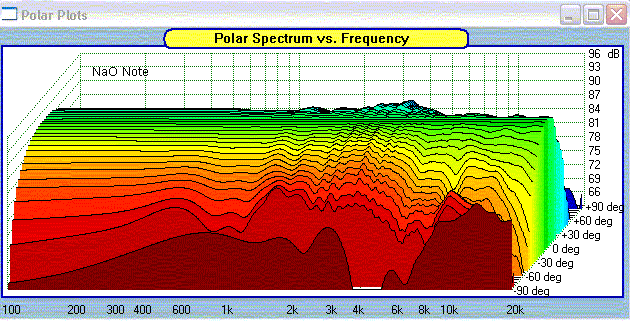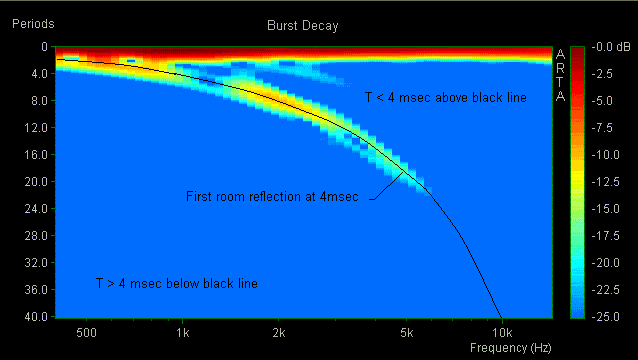NaO Design.....
___________________________
The NaO Note Details.
Discontinued
___________________________
The NaO Note Details.
Discontinued

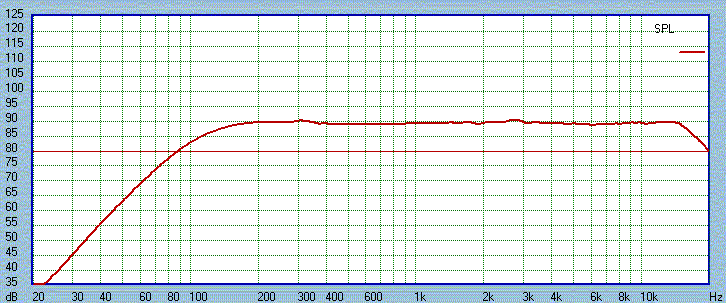
On Axis Frequency Response of the NaO Note Panel
The on axis response of the NaO Note panel was designed to follow a 4th order, Riley/Linkwitz, 110 Hz high
pass response. The data below show that this target has been achieved. The response shown is a
combination of a 1/6 octave smoothed far field measurement combined with a dipole corrected near field
measurement below 385Hz. The panel response is carefully integrated with the NaO U-frame woofer system
extending the response to below 30 Hz.
The on axis response of the NaO Note panel was designed to follow a 4th order, Riley/Linkwitz, 110 Hz high
pass response. The data below show that this target has been achieved. The response shown is a
combination of a 1/6 octave smoothed far field measurement combined with a dipole corrected near field
measurement below 385Hz. The panel response is carefully integrated with the NaO U-frame woofer system
extending the response to below 30 Hz.
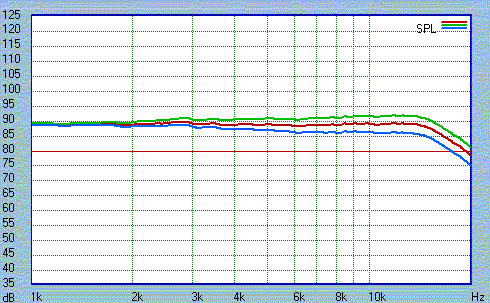
Active crossover Tweeter level Control
This next plot shows the effect of the active crossover tweeter level control which gives the listener the ability to
adjust the tweeter level to his taste or listening environment.
This next plot shows the effect of the active crossover tweeter level control which gives the listener the ability to
adjust the tweeter level to his taste or listening environment.
NaO Note Polar Response, Front Hemisphere
One of the major design objectives of the NaO Note was to improve upon the polar response of typical dipole speakers
using a simple 2-way midrange/tweeter configuration. As can be seen, this objective has been accomplished. The polar
response is very uniform to 4k Hz. Above 4k HZ the polar pattern begins to narrow somewhat. The amplitude of the off axis
response is always less than or equal to that of the on axis response and decreases monotonically as the off axis angle
increase. Thus there are no "hot spots" for off axis listeners. Only above 8k Hz is there and indication of beaming and this
occurs beyond 45 degrees.
One of the major design objectives of the NaO Note was to improve upon the polar response of typical dipole speakers
using a simple 2-way midrange/tweeter configuration. As can be seen, this objective has been accomplished. The polar
response is very uniform to 4k Hz. Above 4k HZ the polar pattern begins to narrow somewhat. The amplitude of the off axis
response is always less than or equal to that of the on axis response and decreases monotonically as the off axis angle
increase. Thus there are no "hot spots" for off axis listeners. Only above 8k Hz is there and indication of beaming and this
occurs beyond 45 degrees.
NaO Note Polar surface, Front Hemisphere
The same polar data is presented in the form of a surface plot below. This more clearly shows the uniformity of the polar
response with frequency. Also note that the scale has been changed to 3dB/division to highlight the improvement.
The same polar data is presented in the form of a surface plot below. This more clearly shows the uniformity of the polar
response with frequency. Also note that the scale has been changed to 3dB/division to highlight the improvement.
NaO Note Burst Response
The flat on axis response of the NaO Note also indicates a freedom from significant resonances. This is further
born out by examining the burst response. The tail hanging down to the right is a result of a room reflection which
occurs at approximately 4 msec.
The flat on axis response of the NaO Note also indicates a freedom from significant resonances. This is further
born out by examining the burst response. The tail hanging down to the right is a result of a room reflection which
occurs at approximately 4 msec.

NaO Note Passive Crossover Schematic
The schematic of the NaO Note passive panel crossover reveals the 3.5 way design. The resistors, RLS and RPS
are omitted from the crossover as designed and only provided to allow the listener/builder the opportunity to "pad
down" the midrange to tweeter coupler if desired. Due the nature of the impedance of the ScanSpeaker
Discovery 10F driver simple Lpad attenuation can be used.
The schematic of the NaO Note passive panel crossover reveals the 3.5 way design. The resistors, RLS and RPS
are omitted from the crossover as designed and only provided to allow the listener/builder the opportunity to "pad
down" the midrange to tweeter coupler if desired. Due the nature of the impedance of the ScanSpeaker
Discovery 10F driver simple Lpad attenuation can be used.
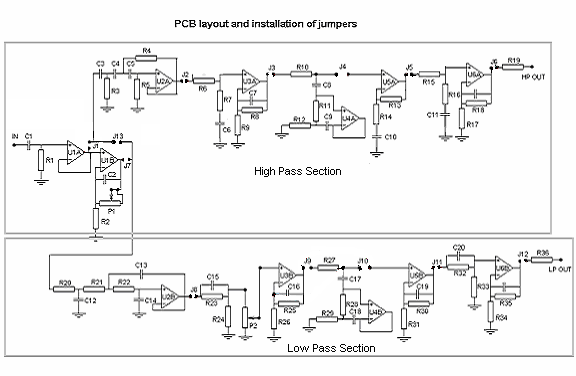
NaO Note Active Crossover Equalization Unit (ACEU) Schematic
As with the NaO II and NaO Mini, the active circuits used for the NaO Note are kept as simple as possible. A total of
only 6 dual operational amplifiers are used in each.
As with the NaO II and NaO Mini, the active circuits used for the NaO Note are kept as simple as possible. A total of
only 6 dual operational amplifiers are used in each.
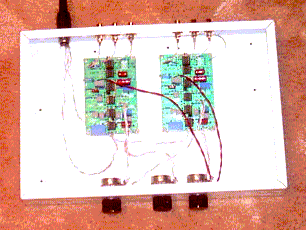
Completed ACEU (apologies for poor picture quality)
The completed active crossover can be housed in a very compact enclosure. The printed circuit boards are separate for
each chanel and measure only 2 1/2" x 3 3/4". the crossover is powered by an external power supply. A recommended
power supply is listed in the plan set, or any desired +V / G / -V of between +/-12 to +/-15 volts DC can be used.
The completed active crossover can be housed in a very compact enclosure. The printed circuit boards are separate for
each chanel and measure only 2 1/2" x 3 3/4". the crossover is powered by an external power supply. A recommended
power supply is listed in the plan set, or any desired +V / G / -V of between +/-12 to +/-15 volts DC can be used.
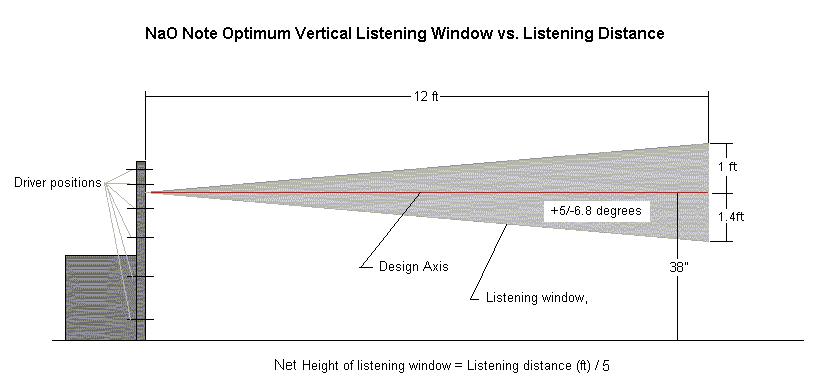
NaO Note Height of Optimum Vertical Listening Window vs. DistanceVertical
A trade off in obtaining the improved horizontal polar response is a narrower vertical listening window. This is a result of the
higher crossover frequency to the NeO 3 tweeter. At a distance of 12 ft the vertical listening window is about 2.4 ft as defined
by the vertical position where the response at any frequency deviates by more than 5 dB from the on axis response. The main
baffle can be tilted, if necessary, to redirect the optimum listening window.
A trade off in obtaining the improved horizontal polar response is a narrower vertical listening window. This is a result of the
higher crossover frequency to the NeO 3 tweeter. At a distance of 12 ft the vertical listening window is about 2.4 ft as defined
by the vertical position where the response at any frequency deviates by more than 5 dB from the on axis response. The main
baffle can be tilted, if necessary, to redirect the optimum listening window.
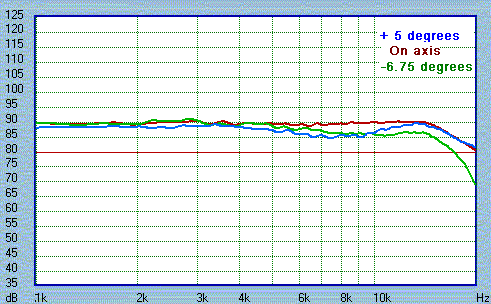
Variation of Axial Response Over Optimum Listening Window
Below is an indication of just how the vertical response varies over the listening window. The response is well controlled
and never exceed the on axis response.
Below is an indication of just how the vertical response varies over the listening window. The response is well controlled
and never exceed the on axis response.
